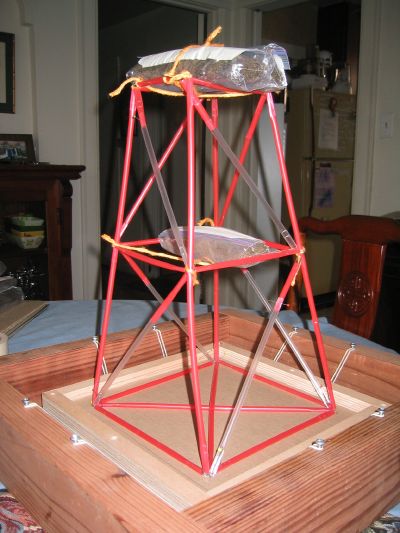 Earthquake Tower Project
Earthquake Tower Project
Vocabulary
Foundation
Height-base ratio
Symmetry
Truss
Logistics
Grouping
Groups of 2-3 students.
Materials
Each group of students can use:
- 1 cardboard base (approximately 25 cm by 25 cm)
- 30 straws
- 100 paper clips (one box, any size)
- 20 straight pins
- 2 meters of string
Briefly, the structures must meet the following requirements:
- The building must fit on the base.
- The building must be at least 36 cm tall.
- The building must have 2 stories that are each at least 18 cm tall (approximately the height of 1 straw).
- Each story must support the weight of at least 1 sand bag (250 grams) without collapsing.
- A construction drawing with measurements and analysis must be submitted before construction begins.
- To survive an earthquake test, the building must not collapse for 10 seconds after the earthquake begins. The weights must stay on the building.
If at any point the structure buckles to the point that the sandbags fall off or \drop by more than halfway to the ground (a sandbag on the first story 18 cm high can fall as much as 9 cm and still be considered passing while a sandbag on the second story 36 cm off the ground can fall 18 cm) the structure will have failed that stage of testing. Students will have 2 minutes to repair any damage to their structure between each stage of testing although no new straws or materials are to be provided.
Here is how a test will run:
- Place 1 sandbag on the first story.
- Place 1 sandbag on the second story.
- Minor earthquake with 1 sandbag on the top story (moving the platform horizontally to the side so that it touched the frame starts a minor earthquake)
- Major earthquake with 1 sandbag on the top story (moving one corner of the platform so that it touched the corner of the frame as well as the table below started a major earthquake, both horizontal and vertical motion)
- Major earthquake with 1 sandbag on the top story and 1 sandbag on the first story.
- Major earthquake with 2 sandbags on the top story and 1 sandbag on the first story.
- Major earthquake with 2 sandbags on the top story and 2 sandbags on the first story.
- Continue major earthquakes adding 1 sandbag at a time, first to the top story, then to the first story.
Questions to consider:
- Strategies for how to secure the structure to the foundation using paper clips, pins and/or string.
- Would a better structure have a wide base of a narrow base?
- Would a better structure be symmetrical or asymmertrical?
- A description of trusses and cross-bracing and discussion of their use in bridges, earthquake retrofitting, and other structural engineering.
- How can you secure the sand bags so that they don’t fall off?
Note the "Trampoline" Design of the Shake Table
 The Giants Rock
The Giants Rock
Comments (0)
You don't have permission to comment on this page.